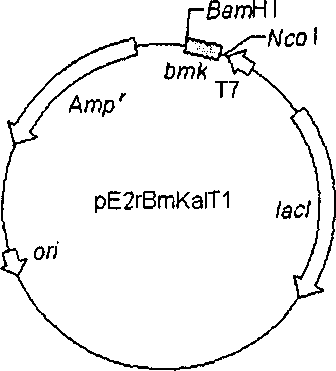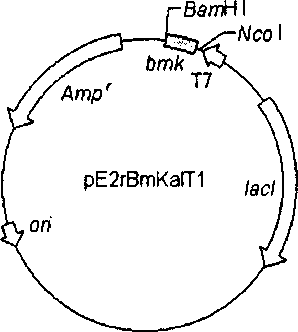Genetic engineering for recombining scorpion venom rBmKaIT1
A technology of Malanobis pliers and scorpion venom, applied in the field of molecular biology, can solve the problems of abnormal sodium ion permeability, etc., and achieve the effect of less time-consuming and high economic benefits
- Summary
- Abstract
- Description
- Claims
- Application Information
AI Technical Summary
Problems solved by technology
Method used
Image
Examples
Embodiment 1
[0112] Design, total synthesis and cloning of rBmKαIT1 gene of recombinant East Asian scorpion venom rBmKαIT1:
[0113] A. Design of the structural gene encoding the rBmKαIT1 of recombinant East Asian scorpion venom rBmKαIT1
[0114] After inputting the amino acid sequence of the rBmKαIT1 recombinant East Asian scorpion venom rBmKαIT1 into the computer, run the DNAStar software, according to (1) codon usage frequency of highly expressed genes in Escherichia coli, (2) evenly place a single restriction enzyme in the recombinant East Asian horse In the rBmKαIT1 synthetic gene of the venomous venomous venom, (3) the segmentation of the synthetic gene fragments and the elimination of self-pairing of the fragments require manual selection of codons for each amino acid to determine the DNA sequence of the rBmKαIT1 structural gene of the recombined East Asian venomous venomous rBmKαIT1 ,As shown in Figure 1.
[0115] B. Preparation of oligonucleotide fragments
[0116] Oligonucleoti...
Embodiment 2
[0123] gene expression:
[0124] Plasmid pE2rBmKαIT1 was transformed into Escherichia coli BL21(DE3). A single colony was taken and inserted into 5 ml of LB medium containing Amp (100 μg / ml), and shaken at 37° C. overnight. Then inoculated in 100ml of the above-mentioned medium at a ratio of 1:100, and cultured at 37°C until A 600 0.6, then inoculated in 1L of the above medium at a ratio of 1:100, and cultured at 37°C until A 600 was 0.6, IPTG was added to a final concentration of 0.4mmol / L, and the induction was continued for 4-6 hours. The expression product was detected by 10% Tris-Tricine SDS-PAGE, and the results were shown in Figure 8.
Embodiment 3
[0126] In vitro renaturation and separation and purification of expressed products
[0127] A. Preparation of inclusion body: At 4°C, centrifuge (5,500g) to collect the Escherichia coli cells after induction and expression, and resuspend the bacteria in 20ml buffer A (buffer A consists of 50mmol / L Tris-Cl ( pH 7.5), 2.5mmol / L EDTA, 20mmol / L β-mercaptoethanol), add lysozyme and PMSF to the final concentration of 0.2mg / ml and 1mmol / L, respectively, place in ice bath for 1 hour, and ultrasonically break the bacteria for 10 Minutes (~150W, ultrasonic for 30 seconds, intermittent for 30 seconds), centrifuge at 15,000g for 20 minutes to collect the precipitate. The precipitate was washed successively with 3×20 ml of buffer A (adding 1% (v / v) Triton X-100) and 20 ml of buffer A (containing 2 mol / L guanidine hydrochloride). Before each wash, resuspend the pellet in buffer and stir at room temperature for 30 minutes, then centrifuge to collect the pellet. This preparation is the pure...
PUM
| Property | Measurement | Unit |
|---|---|---|
| molecular weight | aaaaa | aaaaa |
Abstract
Description
Claims
Application Information
 Login to View More
Login to View More - R&D
- Intellectual Property
- Life Sciences
- Materials
- Tech Scout
- Unparalleled Data Quality
- Higher Quality Content
- 60% Fewer Hallucinations
Browse by: Latest US Patents, China's latest patents, Technical Efficacy Thesaurus, Application Domain, Technology Topic, Popular Technical Reports.
© 2025 PatSnap. All rights reserved.Legal|Privacy policy|Modern Slavery Act Transparency Statement|Sitemap|About US| Contact US: help@patsnap.com



